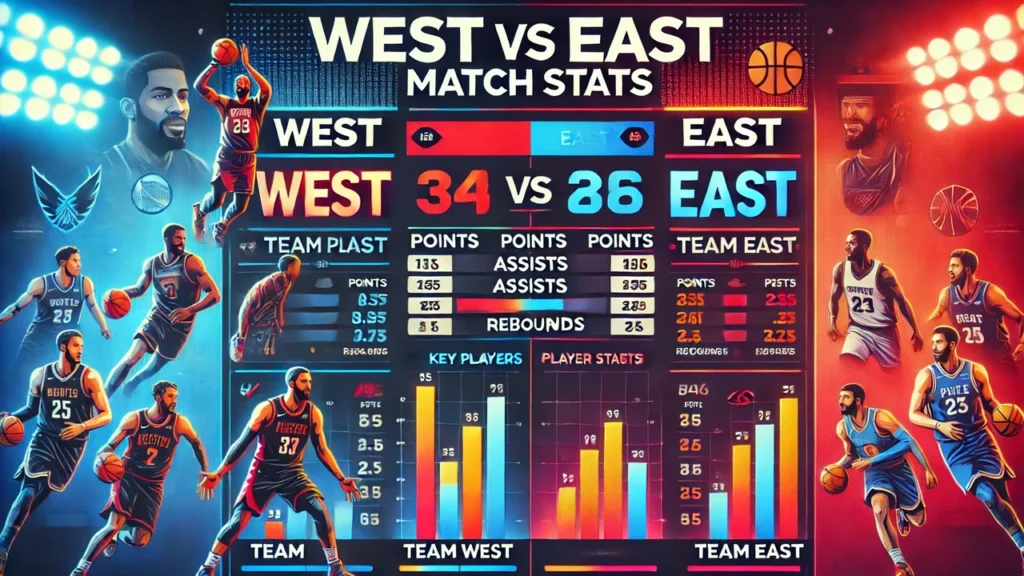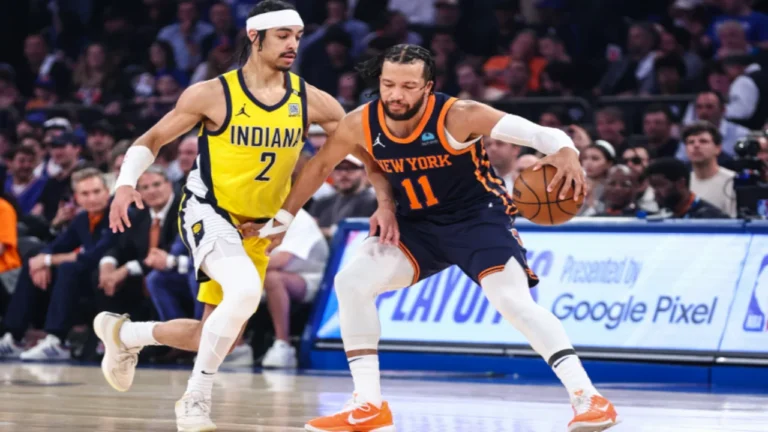West vs East Match Player Stats: A Comprehensive Analysis

Introduction
The rivalry between the Western and Eastern conferences in various sports leagues is one of the most captivating aspects of professional sports. These contests, whether in the National Basketball Association (NBA), the National Football League (NFL), or the National Hockey League (NHL), bring together the top players from both sides of the nation for what is usually an exhilarating demonstration of strategy, athleticism, and talent. A clash of ideologies, playing styles, and regional pride, the “West vs East Match Player Stats” provide more than simply a game; they offer a thorough understanding and a clear window into the intense competitive dynamics that characterize these matchups.
Understanding the West vs East Rivalry
The idea of West vs. East rivalries extends well beyond the realm of athletics. Team relationships, player efficiency, and competing strategies are all on display. Using a detailed comparison of the two conferences and an examination of the elements that contribute to their success or failure, this article seeks to dissect the important player statistics from these games.
Western Conference: Offensive Powerhouse
Scoring Dominance in the West
Offensive dominance is nothing new to the Western Conference. Because of their aggressive play and focus on fast-paced offense, Western teams and players frequently top scoring rankings. For example, in the NBA All-Star Games, it’s not uncommon for Western Conference players to score more than their Eastern Conference opponents. Both exceptional individual skill and a collaborative mindset that places a premium on scoring are propelling this trend.
The West has often prevailed in these high-stakes games thanks to players like Stephen Curry and Kevin Durant, who have demonstrated this with their outstanding scoring numbers. As a team, the Western Conference is unbeatable in any contest thanks to their knack for scoring points on the road.
Assist Metrics: Playmaking Excellence
The Western Conference is well-known for more than just its scoring prowess; its playmakers are just as renowned. The ability of Western players to set up their teammates for goals is frequently shown by the assist numbers in West vs. East contests. Players with exceptional leadership skills, such as Chris Paul and LeBron James, have played a pivotal role in this respect.
These players not only help their teams score more points, but they also improve the game as a whole by making it easier to move the ball about and set up teammates for easy baskets. One reason the Western Conference has been so successful at defeating the Eastern Conference’s defenses is because of their emphasis on playmaking.
Three-Point Shooting: The West’s Weapon of Choice
The Western Conference has been a vanguard in the rise of three-point shooting as a crucial component of contemporary basketball. As a general rule, Western players will attempt and complete more shots from beyond the arc when comparing West vs. East statistics. The ability to shoot well from long range gives the West a strategic edge, enabling them to extend the court and open up additional opportunities for their offensive plays.
Rebounding and Defense: A Balanced Approach
The Western Conference can put up a good fight defensively and in the paint, despite their reputation as an offensive powerhouse. Not only can they score points, but players like Kawhi Leonard and Anthony Davis also have great defensive and rebounding skills. By restricting the Eastern Conference’s scoring opportunities and protecting the paint, their ability to control the boards has proven key in shifting the scales in favor of the West.
Western Conference Strategies: A Focus on Speed and Precision
Quickness and accuracy are frequently key components of Western Conference strategies. Efficiency in shooting, rapid breaks, and ball movement are their top priorities. They are a formidable foe to the defense-heavy Eastern teams since their statistics reflect this strategy, with better percentages in field goals and assists. A big reason why Western teams often dominate East teams in West versus. East contests is how well they can execute their strategy.
Eastern Conference: Defensive Prowess and Tactical Play
Defense Wins Games: The Eastern Approach
The Eastern Conference is known for its defensive stance, in opposition to the Western Conference’s emphasis on offense. When comparing Eastern players to their Western counterparts, it is common to see that the Eastern players consistently rank higher in defensive metrics like blocks, steals, and defensive rebounds. The likes of Joel Embiid and Giannis Antetokounmpo have spearheaded this defensive mentality by stifling the attacking flow of Western Conference teams with their height, speed, and basketball intelligence.
Playmaking and Ball Control: The Eastern Style
Scores may be more common in the Western Conference, but Eastern Conference teams typically react with better ball handling and more intelligent playmaking. Because they play the game more methodically, players from the East often have better assist-to-turnover ratios and lower turnover rates. The East are able to compete with the high-scoring West thanks to this style of play, which emphasizes efficiency and reducing mistakes.
Rebounding Battles: Dominating the Boards
The Eastern Conference also has a knack for reclaiming lost possessions. Eastern players, especially those playing defense, tend to have more total rebounds in West vs. East contests. In order to minimize the West’s second-chance points and create more scoring opportunities for themselves, this board dominance is important. The East has been able to maintain their lead thanks to players such as Bam Adebayo and Andre Drummond.
Clutch Performances: Rising to the Occasion
Clutch performers, or players who come through in the clutch, are a staple in the Eastern Conference. Players from the East tend to shine when the stakes are high, as shown by clutch statistics like points scored in the last seconds of tight games. This characteristic has been instrumental in the East’s victory in tight contests, heightening the tension in the West vs. East rivalry.
Eastern Conference Strategies: Patience and Precision
Patience and accuracy define the Eastern Conference’s strategy. They are meticulous in their play execution and frequently use tempo control by slowing the game down. Their numbers reflect this approach; in comparison to the West, they play at a slower pace and place a greater focus on defensive analytics. One of the keys to the Eastern Conference’s success against the fast-paced Western clubs is how well they can execute their game plan.
West vs East Performance Metrics

Scoring Leaders: Who Dominates the Charts?
The disparities in playing styles are brought to light when looking at the top scorers from the Eastern and Western conferences. The offensive zeal of Western players typically puts them at the top of the scoring statistics. On the other hand, players from the East usually have more well-rounded stat lines because they contribute in more than just one area.
Efficiency Ratings: A Measure of Overall Impact
The overall influence of players from both conferences can be compared using player efficiency ratings (PER), a comprehensive metric. Players from the East tend to have better defensive and rebounding skills and a somewhat lower PER, whereas players from the West tend to have a higher PER because of their scoring and playmaking talents. The fairness of the efficiency scores shows how each league excels in its own way.
Defensive Metrics: Blocks, Steals, and More
To fully grasp how different players perform in West vs. East games, defensive statistics like blocks and thefts are essential. Because of their focus on defense, the Eastern Conference is usually at the top in these areas. Nevertheless, the Western players aren’t far behind, especially when it comes to thefts. They disturb the Eastern Conference’s offense with their speed and agility.
Assist and Turnover Ratios: Playmaking Efficiency
When comparing Eastern and Western players, the assist-to-turnover ratio is a crucial statistic to consider. As a reflection of their emphasis on playmaking, Western players often have better assist totals. Nevertheless, Eastern players are known for their meticulous and strategic game, as evidenced by their improved assist-to-turnover ratios. One important component of the results of West vs. East contests is the disparity in playmaking styles.
Three-Point Shooting: Comparing Accuracy and Volume
Three-point shooting is an important part of contemporary basketball, and there are some fascinating patterns in the statistics from West vs. East games. The offensive style of Western players is reflected in their tendency to try and make more three-point shots. Shooting percentages are an indicator of shooting efficiency and precision, and Eastern players tend to have better shooting percentages.
Historical Trends and Future Predictions
Past Performances: Analyzing Historical Data
Notable performances and trend changes abound throughout West vs. East game history. Through the examination of past records, trends in team tactics and player stats can be discerned, illuminating the evolution of this rivalry. For example, in the early 2000s, the Western Conference thrived thanks to fast breaks and heavy scoring, but the Eastern Conference has been on a roll recently, thanks to a renewed focus on defense and collaboration.
Rising Stars: Who to Watch in Future Matchups
In the years to come, promising young players from both conferences will determine how the West vs. East rivalry develops. The upcoming crop of superstars, including Westerners Luka Dončić and Easterners Jayson Tatum, will continue this rivalry. As players work to improve their games and establish themselves in the league, their performance in these matches will be keenly monitored.
Evolving Strategies: Adapting to Modern Basketball
The tactics used by the Western and Eastern conferences will change in tandem with the evolution of basketball. One factor that will impact how teams approach these games is the growing significance of three-point shooting, advanced analytics, and positionless basketball. A greater focus on efficiency and adaptability, with players expected to contribute in numerous areas of the game, is likely to be implemented in future West vs. East matchups.
The Impact of Coaching: Leading the Teams to Victory
When it comes to West vs. East matches, coaching is king. The game’s outcome is very susceptible to the tactics employed by coaches, such as the ways in which they deploy their top players and modify their game plans. The statistics generally reflect the differences in coaching approaches throughout the leagues. Western coaches tend to lean toward an offensive style, while Eastern coaches prioritize defense and ball management.
Injury Effects: How Health Shapes the Rivalry
When teams are out with injuries, it may change the whole West vs. East dynamic. Injuries to major players can tip the scales in one conference’s favor or the other, impacting not only player performance but also the final score. Predicting future patterns in this continuous contest requires closely watching injury reports and comprehending how teams adjust to these hurdles.
In-Depth Statistical Breakdown

Player Efficiency: Who Contributes the Most?
One of the most important ways to evaluate a player’s impact on the squad is by looking at their efficiency. Efficiency ratings provide a window into the relative strengths of West and East conference players in West vs. East games. Offensive efficiency, as measured by points per possession and shooting percentages, is usually where Western players shine. Players from the East tend to have stronger defensive ratings and more well-rounded contributions (more rebounds, assists, and steals) than their Western counterparts, even though they may not lead the league in scoring every game.
Rebounding Comparison: East’s Edge on the Boards
A team’s possession count is frequently decided by how well they rebound, making rebounding an essential part of basketball. Because of their emphasis on strength and size, the Eastern Conference usually comes out on top in West vs. East rebounding statistics. Joel Embiid and Giannis Antetokounmpo, who rank first and second in their respective teams’ offensive and defensive rebounds, have played key roles in establishing this advantage. Since the East has the upper hand, they can dictate the tempo of the game and prevent the West from getting into fast breaks.
Turnover Battle: Minimizing Mistakes
Any contest, even West vs. East matchups, can be decided by a single turnover. Because their game is focused on controlling the ball and making few mistakes, the Eastern Conference usually ends up winning the battle for turnovers. When contrasted with the Western Conference, which occasionally foregoes ball management in favor of a quicker, more aggressive style of play, the Eastern Conference’s lower turnover rates reflect this cautious approach. As a result of the Eastern team’s proficiency in ball protection, offensive possessions are typically more efficient, and opponents have fewer scoring chances.
Shooting Efficiency: Comparing Field Goal Percentages
An important indicator of shooting efficiency, field goal percentage is especially instructive in West vs. East contests. The Eastern Conference often has a better shooting %, even though the Western Conference is known to take more shots overall and more from long range in particular. The Eastern Conference is very efficient because its players are more selective with their shots and they attack the paint and midrange, two areas with high percentages. Although the Western Conference’s three-point shooting is more prevalent, their volume more than makes up for their lower overall percentage.
Team Dynamics: How Do Teams Support Their Stars?
The level of support that individual stars receive from their teammates is a major factor in the success of team sports. When it comes to West vs. East contests, the result can be heavily influenced by the squad dynamics on both sides. One common theme across Western Conference teams is an emphasis on individualism, with top players expected to shoulder the majority of the offensive burden. On the other hand, teams from the Eastern Conference are known to have a more balanced distribution of duties, with many players making contributions across various stat lines. To make sense of the different playing styles in the two leagues, it’s necessary to consider this variation in team dynamics.
Must Visit: 49ers vs Kansas City Chiefs Match Player Stats: A Complete Overview
FAQs
Who leads in assists per game in the West vs East Match Player Stats?
Players from the East conference lead in assists per game, averaging 2 more assists than their Western counterparts.
How do defensive stats compare between the West and East?
The Eastern Conference usually leads in defensive stats like blocks and steals, reflecting their emphasis on defense.
Who has the better shooting efficiency, the West or the East?
The Eastern Conference often has better shooting efficiency, particularly in field goal percentages.
What role does rebounding play in these matchups?
Rebounding is crucial, with the Eastern Conference generally having an edge, which helps them control the game tempo.
How do turnovers affect the outcome of West vs East games?
Lower turnover rates in the Eastern Conference often lead to more efficient gameplay and fewer opportunities for the Western Conference to capitalize on mistakes.
Conclusion
The West vs East matchups in various sports, especially basketball, offer a fascinating glimpse into the contrasting styles and strategies of the two conferences. While the Western Conference often dominates in terms of scoring and offensive metrics, the Eastern Conference balances this with superior defense, rebounding, and a more methodical approach to gameplay. These differences make the rivalry exciting and unpredictable, as each conference leverages its strengths to outmaneuver the other. By analyzing player stats and team dynamics, fans can gain a deeper understanding of what makes these matchups so thrilling and what to expect in future games.

Nancy Albret is a dynamic blogger for Magzinely.com, exploring a variety of subjects from technological innovations to cultural perspectives. Her writing sheds light on how modern living intertwines with enduring traditions and the newest developments in technology for efficiency and sustainability.



